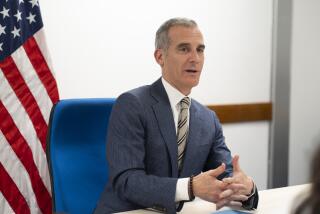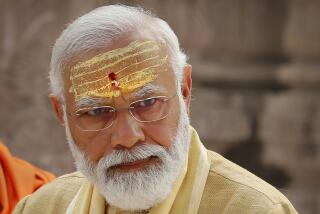Washington’s Turn Next in World’s ‘Courtship of Rajiv Gandhi’
- Share via
NEW DELHI — The long-running “courtship of Rajiv Gandhi” is about to open in Washington after playing in Moscow, Cairo, Paris and Algiers.
But the Indian prime minister’s performance in the role of the world’s most eligible nonaligned ruler was the rave of diplomatic circles here long before he took it on the road, beginning last month in the Soviet Union.
He arrives in Washington today for a state visit and will meet with President Reagan at the White House on Wednesday.
Shy Political Style
After more than seven months in office since taking over for his assassinated mother, Indira Gandhi, Rajiv Gandhi defies characterization. His own rather shy political style and emotionless manner have kept him from tipping his hand. He cannot be described as pro-American or pro-Soviet.
Gandhi’s apparent independence has suited him perfectly for his role as leader of the nonaligned movement, and it has brought him a seemingly unending series of visitors from both Western and Eastern blocs.
U.S. visitors have included Secretary of Commerce Malcolm Baldrige, Air Force Secretary Verne Orr, Under Secretary of Defense Fred C. Ikle and several delegations of congressmen and senators.
“This new government is an ‘up’ period for us,” a senior Defense Department official said, “a new chapter in Indo-U.S. relations.”
In March, when India’s new budget was announced, it was instantly heralded as manifesting a shift to Western, free-market values from the rigid state socialism that was the economic policy of Indira Gandhi and her father, Jawaharlal Nehru. A Wall Street Journal editorial dubbed Gandhi “Rajiv Reagan.”
In a speech May 8 in Madrid, Reagan praised Gandhi’s economic policies, calling them an “economic revolution” built on driving down taxes, reducing tariffs and providing market incentives--all familiar elements of Reagan programs.
A week later, however, Gandhi, sitting cross-legged on a pillow before a sea of white khadi -clothed members of his ruling Congress-I Party, reaffirmed his government’s commitment to socialism and socialist economic policies.
And Gandhi’s enthusiastic visit to the Soviet Union at the end of May is also likely to have dampened the spirits of some India-wooers in the West. Gandhi reportedly wowed the Soviet public. “He is the most handsome leader in the world,” exclaimed one young woman on Soviet television.
He reaffirmed his country’s appreciation for what he called the Soviet Union’s 37 years of steadfast friendship and mutual cooperation and signed a $1-billion-plus defense agreement that gives India special terms for purchasing Soviet weapons. Whatever India purchases in Indian rupees, the Soviet Union has agreed to spend on consumer goods and raw materials from India.
Finally, Gandhi and Soviet leader Mikhail S. Gorbachev appeared to get along famously. Gorbachev arrived 15 minutes early for their meeting and took Gandhi on a walk. Along the way, he broke off a lilac blossom and presented it to Gandhi.
After returning from the Soviet trip, Gandhi refused to openly criticize the Soviet intervention in Afghanistan, where more than 120,000 Soviet troops are stationed, except to say that India is opposed to all interventions by all outside powers into other countries’ affairs.
New Delhi political columnist G. K. Reddy cautioned Americans against being overly optimistic about the potential of the Gandhi visit: “No matter who is in power in India, one cannot reverse its course and change its relations with Russia. . . . “
More to Read
Sign up for Essential California
The most important California stories and recommendations in your inbox every morning.
You may occasionally receive promotional content from the Los Angeles Times.













